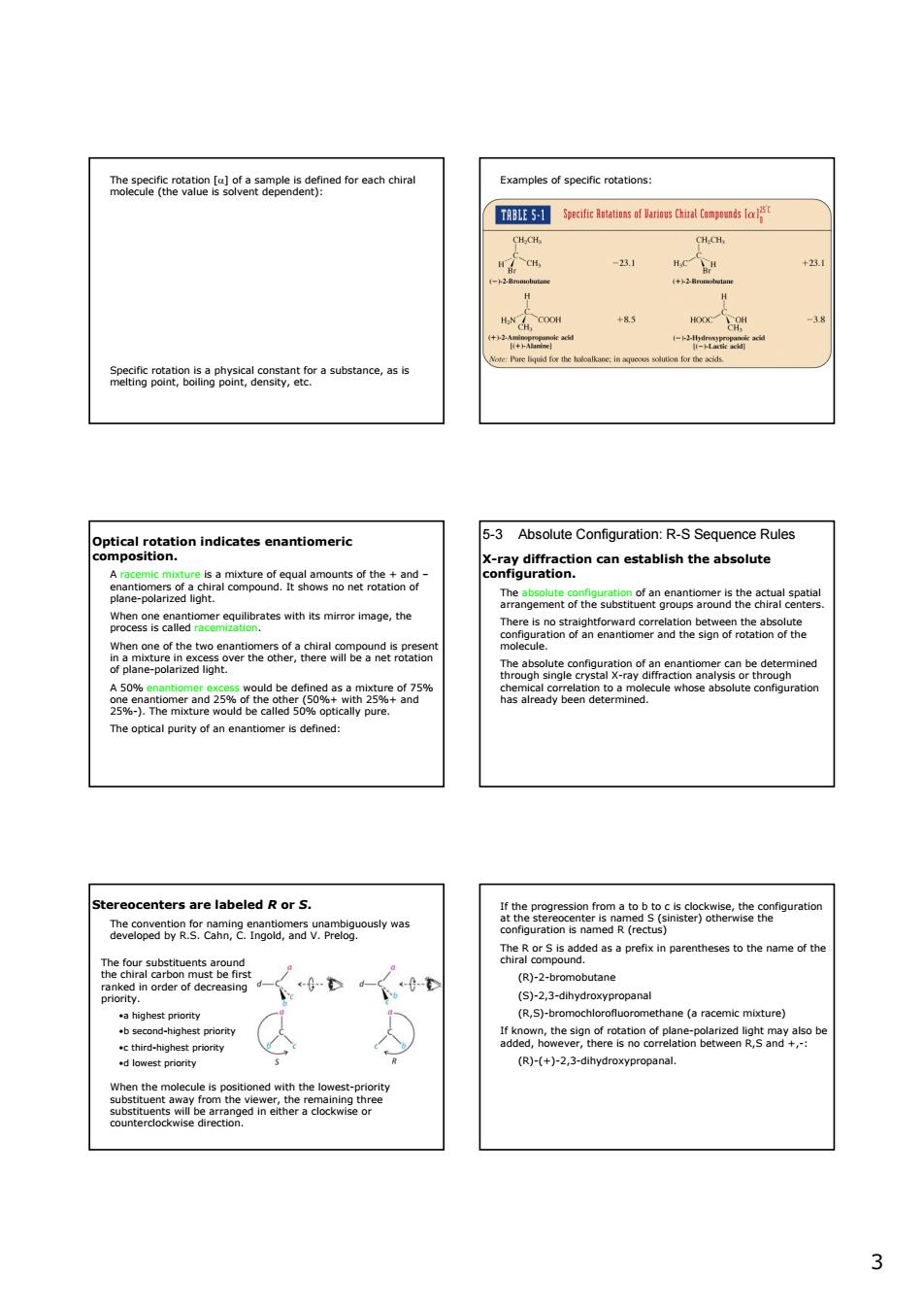正在加载图片...

moleforcia Examples of specific rotations: pcfic tians ofris Chiral Cemges o 281 f +28 onbstance. 5-3 Absolute Configuration:R-S Sequence Rules can establish the absolute mteasgneea时iomereaubrateswithsmroemage,he 8g tical punty of an enar labeled RorS. 9aaRa2goawa ge25oauo (R)-2-b -(+-23d 33 The specific rotation [α] of a sample is defined for each chiral molecule (the value is solvent dependent): [ ] where [ ] = specific rotation t = temperature in degrees Celsius = wavelength of incident light (D = 589 nm, the yellow D line from Na) o t l c λ α α α λ = × = observed optical rotation in degres l = sample container length in dm c = concentration (g/ml) α Specific rotation is a physical constant for a substance, as is melting point, boiling point, density, etc. Examples of specific rotations: Optical rotation indicates enantiomeric composition. A racemic mixture is a mixture of equal amounts of the + and – enantiomers of a chiral compound. It shows no net rotation of plane-polarized light. When one enantiomer equilibrates with its mirror image, the process is called racemization. When one of the two enantiomers of a chiral compound is present in a mixture in excess over the other, there will be a net rotation of plane-polarized light. A 50% enantiomer excess would be defined as a mixture of 75% one enantiomer and 25% of the other (50%+ with 25%+ and 25%-). The mixture would be called 50% optically pure. The optical purity of an enantiomer is defined: [ ] [ ] % optical purity 100 enantiomer excess observed α α ⎛ ⎞ = ×= ⎜ ⎟ ⎝ ⎠ 5-3 Absolute Configuration: R-S Sequence Rules X-ray diffraction can establish the absolute configuration. The absolute configuration of an enantiomer is the actual spatial arrangement of the substituent groups around the chiral centers. There is no straightforward correlation between the absolute configuration of an enantiomer and the sign of rotation of the molecule. The absolute configuration of an enantiomer can be determined through single crystal X-ray diffraction analysis or through chemical correlation to a molecule whose absolute configuration has already been determined. Stereocenters are labeled R or S. The convention for naming enantiomers unambiguously was developed by R.S. Cahn, C. Ingold, and V. Prelog. The four substituents around the chiral carbon must be first ranked in order of decreasing priority. •a highest priority •b second-highest priority •c third-highest priority •d lowest priority When the molecule is positioned with the lowest-priority substituent away from the viewer, the remaining three substituents will be arranged in either a clockwise or counterclockwise direction. If the progression from a to b to c is clockwise, the configuration at the stereocenter is named S (sinister) otherwise the configuration is named R (rectus) The R or S is added as a prefix in parentheses to the name of the chiral compound. (R)-2-bromobutane (S)-2,3-dihydroxypropanal (R,S)-bromochlorofluoromethane (a racemic mixture) If known, the sign of rotation of plane-polarized light may also be added, however, there is no correlation between R,S and +,-: (R)-(+)-2,3-dihydroxypropanal